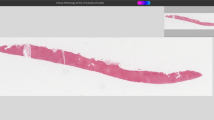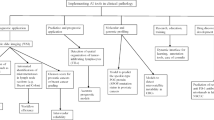Abstract
Digital pathology (DP) is increasingly entering routine clinical pathology diagnostics. As digitization of the routine caseload advances, implementation of digital image analysis algorithms and artificial intelligence tools becomes not only attainable, but also desirable in daily sign out. The Swiss Digital Pathology Consortium (SDiPath) has initiated a Delphi process to generate best-practice recommendations for various phases of the process of digitization in pathology for the local Swiss environment, encompassing the following four topics: i) scanners, quality assurance, and validation of scans; ii) integration of scanners and systems into the pathology laboratory information system; iii) the digital workflow; and iv) digital image analysis (DIA)/artificial intelligence (AI). The current article focuses on the DIA-/AI-related recommendations generated and agreed upon by the working group and further verified by the Delphi process among the members of SDiPath. Importantly, they include the view and the currently perceived needs of practicing pathologists from multiple academic and cantonal hospitals as well as private practices.
Zusammenfassung
Digitale Pathologe (DP) wird zunehmend in der Routinediagnostik der klinischen Pathologie eingesetzt. Mit fortschreitender Digitalisierung der Routinefälle wird die Implementierung digitaler Bildanalysealgorithmen und künstlicher Intelligenz nicht nur machbar, sondern auch für die tägliche Praxis wünschenswert. Das Schweizer Konsortium für Digitale Pathologie (Swiss Digital Pathology Consortium, SDiPath) hat einen Delphi-Prozess initiiert, um Empfehlungen für das beste Vorgehen in Bezug auf verschiedene Phasen des Digitalisierungsprozesses in der Pathologie für die lokalen Verhältnisse in der Schweiz zu erstellen, dazu gehören die folgenden 4 Themen: i) Scanner, Qualitätssicherung und Validierung der eingescannten Schnittpräparate; ii) Integration von Scannern und Systemen in das Laborinformationssystem; iii) der digitale Arbeitsablauf; und iv) digitale Bildanalyse (DIA)/künstliche Intelligenz (KI). Im vorliegenden Beitrag liegt der Schwerpunkt auf den Empfehlungen hinsichtlich DIA und KI, die von einer Arbeitsgruppe erarbeitet und mittels Delphi-Prozess durch die Mitglieder des SDiPath-Konsortiums bestätigt wurden. Wichtig ist, dass sie die Ansichten und die aktuellen Bedürfnisse praktisch tätiger Pathologen aus verschiedenen Lehr- und Kantonsspitälern sowie aus privaten Praxen einbeziehen.
Similar content being viewed by others
Explore related subjects
Discover the latest articles, news and stories from top researchers in related subjects.Avoid common mistakes on your manuscript.
In early 2021, the Swiss Digital Pathology Consortium (SDiPath) initiated a Delphi process to generate best-practice recommendations for various phases of the process of digitization in pathology for the local Swiss environment, encompassing the following four topics: (i) scanners, quality assurance, and validation of scans; (ii) integration of scanners and systems into the pathology laboratory information system; (iii) the digital workflow; and (iv) digital image analysis (DIA)/artificial intelligence (AI). As digital pathology (DP) is increasingly integrated into routine clinical pathological diagnostics by academic and private pathology institutes, setting up national recommendations to standardize procedures and support implementation was perceived as a current need [1,2,3,4]. This includes the implementation of DIA algorithms and AI tools, as they have become increasingly attainable and desirable in daily sign out.
Herein, we briefly outline the recommendations related to the validation and use of DIA and AI as it applies to the algorithm-aided extraction of information from histological images to support clinical decision making. The recommendations generated were drafted by a dedicated DIA/AI working group and were subsequently verified by members of SDiPath (N = 25) using a Delphi process. All members of SDiPath (N > 170) were encouraged to participate. Importantly, the recommendations include the view and the currently perceived needs of practicing pathologists from multiple academic and cantonal hospitals as well as private practices, who comprised 76% of the responding participants. The rest of the participants were scientists, IT personnel, and laboratory staff. We refer the reader to the original guideline publication for an in-depth discussion of the recommendations [5].
Compliance with general quality guidelines
The SDiPath guidelines affirm that DIA/AI intended for diagnostic use needs to be designed in compliance with current laws and regulatory requirements for medical devices, i.e., only officially certified systems (e.g., IVD-CE certified, FDA-approved) or lab-developed systems properly validated with respect to quality control and quality assurance can be applied. Also, and equally important, it is the board-certified pathologist who determines and is legally responsible for the finally rendered diagnosis. If DIA/AI output is used without being approved by a board-certified pathologist, this is considered off-label use. In line with the existing legal requirement to store all glass slides the diagnoses were generated on, we recommend storing the results of the DIA/AI analysis to allow diagnosis retracing. All steps should be documented in a standard operating procedure (SOP) document.
An internal validation of the system on relevant specimens mirroring the real-world clinical use is recommended, even if the system is officially certified (e.g., IVD-CE certified, FDA-approved) to ensure consistency of performance. Documentation of metadata of the scans, the software used, and the validation protocol as well as the performance of the software (reproducibility, intra-observer variability, and known problems regarding performance) should be provided. When validating the system, a concordance testing needs to be carried out and revalidation shall be performed whenever changes are made in the workflow.
Workflow considerations
Quality control steps verifying that the scans are suitable for analysis and that all relevant areas have been analyzed are required. User training, personnel, and technical requirements, as well as SOPs for hardware and software malfunctions and management updates, need to be provided. In-depth information about the type and application of the DIA/AI system used in the diagnostic process (including quality control measures and validation steps) needs to be included into the pathology report. There are also multiple technical properties that were agreed on to be paramount. In short, the DIA/AI systems need to be well integrated into the pathology workflow environment and automated, in order to enable streamlining of the diagnostic process in the era of increasing workload.
Importantly, for the pathologist, it is most desirable to have visual control of the algorithm’s results, and this should highlight the regions which determined its output. Understanding how the system is generating output and decisions becomes increasingly more critical as the level of autonomy of these systems will rise in the future. It is suggested that the systems should enable a feedback loop to improve performance.
As a last comment, finding parallels with the multiple comments regarding where “Back to the Future II” was wrong in predicting current everyday life and technology [6, 7], we appreciate that the technological possibilities and standards as well as knowledge in the field of digital pathology are developing rapidly. The current recommendations, published elsewhere in full length [5], have been generated to facilitate current development and implementation and shall be reviewed and updated as technology advances.
References
Hanna MG, Reuter VE, Samboy J, England C, Corsale L, Fine SW et al (2019) Implementation of digital pathology offers clinical and operational increase in efficiency and cost savings. Arch Pathol Lab Med 143(12):1545–1555
Janowczyk A, Baumhoer D, Dirnhofer S, Grobholz R, Kipar A, de Leval L et al (2022) Towards a national strategy for digital pathology in Switzerland. virchows Arch 481(4):647–652
Koelzer VH, Grobholz R, Zlobec I, Janowczyk A, Swiss Digital Pathology C (2021) Update on the current opinion, status and future development of digital pathology in Switzerland in light of COVID-19. J Clin Pathol 75(10):687–689
Unternaehrer J, Grobholz R, Janowczyk A, Zlobec I, Swiss Digital Pathology C (2020) Current opinion, status and future development of digital pathology in Switzerland. J Clin Pathol 73(6):341–346
the Swiss Digital Pathology Consortium, Janowczyk A, Zlobec I, Walker C, Berezowska S, Huschauer V et al (2023) Swiss digital pathology recommendations: results from a Delphi process conducted by the Swiss digital pathology consortium of the Swiss society of pathology. medRxiv (2023.09.15.23295616)
Schofeld Z (2014) Everything ‘back to the future part II’ got right and wrong about 2015, according to futurists. Newsweek
Shoard C (2015) Back to the future day: what part II got right and wrong about 2015—an A–Z. Guardian
Funding
Open access funding provided by University of Lausanne
Author information
Authors and Affiliations
Corresponding author
Ethics declarations
Conflict of interest
V.H. Koelzer reports being an invited speaker for Sharing Progress in Cancer Care (SPCC) and Indica Labs; advisory board of Takeda; sponsored research agreements with Roche and IAG, all unrelated to the current study. S. Berezowska, G. Cathomas, R. Grobholz, M. Henkel, W. Jochum, M. Kreutzfeldt, K.D. Mertz, M. Rössle, D. Soldini, I. Zlobec and A. Janowczyk declare that they have no competing interests.
For this article no studies with human participants or animals were performed by any of the authors. All studies mentioned were in accordance with the ethical standards indicated in each case.
The supplement containing this article is not sponsored by industry.
Additional information
Publisher’s Note
Springer Nature remains neutral with regard to jurisdictional claims in published maps and institutional affiliations.

Scan QR code & read article online
Rights and permissions
Open Access This article is licensed under a Creative Commons Attribution 4.0 International License, which permits use, sharing, adaptation, distribution and reproduction in any medium or format, as long as you give appropriate credit to the original author(s) and the source, provide a link to the Creative Commons licence, and indicate if changes were made. The images or other third party material in this article are included in the article’s Creative Commons licence, unless indicated otherwise in a credit line to the material. If material is not included in the article’s Creative Commons licence and your intended use is not permitted by statutory regulation or exceeds the permitted use, you will need to obtain permission directly from the copyright holder. To view a copy of this licence, visit http://creativecommons.org/licenses/by/4.0/.
About this article
Cite this article
Berezowska, S., Cathomas, G., Grobholz, R. et al. Digital image analysis and artificial intelligence in pathology diagnostics—the Swiss view. Pathologie 44 (Suppl 3), 222–224 (2023). https://doi.org/10.1007/s00292-023-01262-w
Accepted:
Published:
Issue Date:
DOI: https://doi.org/10.1007/s00292-023-01262-w




